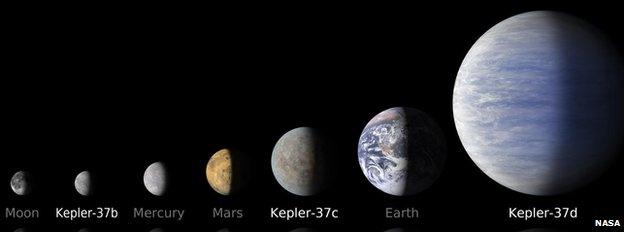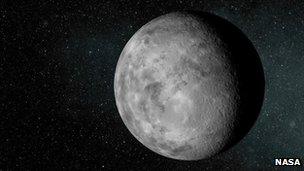Exoplanet Kepler 37b is tiniest yet - smaller than Mercury
- Published

Kepler 37b has a radius not much larger than that of the Moon; Kepler 37d is about twice Earth's radius
Astronomers have smashed the record for the smallest planet beyond our Solar System - finding one only slightly larger than our Moon.
To spot the tiny, probably rocky planet, they first needed to precisely measure the size of its host star.
They did so using "astroseismology" - effectively, turning tiny variations in the star's light into sounds.
A report in Nature, external describes the blistering, probably rocky planet, which orbits its star in just 13 days.
It is joined in this far-flung solar system by two other planets, one three-quarters Earth's size and one twice as large as Earth - all circling their star too closely to harbour liquid water or life.
Moving target
The record for smallest "exoplanet" is routinely being broken, as astronomers get better and better at finding them.
The best tool in the planet-hunters' toolbox is the Kepler space telescope, which stares at a fixed part of the sky, trying to detect the tiny dips in stars' light that happens when planets pass in front of them: what is called a transit event.
In its earliest days, the Kepler team tended to find large planets - Jupiter- and Neptune-sized behemoths. In more recent years, the catalogue of exoplanet has seen an increasing number of so-called super-Earths, up to about twice the radius of our planet.
Only recently has something definitively Earth-sized been found.
But the new find is a planet just a third the size of that recent record-holder, smaller even than our Solar System's smallest planet, Mercury.
"I think it's an amazing technological achievement to be able to be able to detect small rocks like this," said Francois Fressin, a co-author of the paper based at the Harvard-Smithsonian Center for Astrophysics.
"It means we're really in the arena where it's possible to detect all the planets of our Solar System, but around other stars," he told BBC News.
The find of Kepler 37b and its two companions can in part be ascribed to a wealth of data from the Kepler telescope; it has been recording data for nearly four years, and signals that would once have been too small to see have been slowly accumulating, with smaller planets becoming more apparent.
But telling just how small a given planet is depends on a relative measurement: how much light there is when the planet is and is not in front of the host star. The degree to which we can know the planet's size depends on how well we can know the host star's size.
That is where the science of astroseismology comes in - and a team of experts in this area of science at the University of Birmingham in the UK took a look at the data.
"Inside stars it's a very noisy environment, and that noise sets up sound waves that travel all the way through the star," said Birmingham astrophysicist Prof Yvonne Elsworth.
"Some of (the waves) will resonate, just like a musical instrument - the turbulence causes them to ring at frequencies that are characteristic of the star," Prof Elsworth told BBC News.
"If we look at the star we can see those oscillations, the amount of light we get from the star varies - slowly and by a very small amount - at frequencies that tell us what's going on inside the star."
And also like a musical instrument, those "resonant" frequencies tell researchers just how big the star actually is.
'Decade of discovery'
Together, the analyses point to the presence of three planets. Kepler 37b and c are about 30% and 74% as large as the Earth, and Kepler 37d is about twice Earth's radius.

An artist's conception shows what the smallest of the three planets, Kepler 37b, may look like
The three orbit their star in 13, 21, and 40 days respectively - all within orbits just 20% of the Earth-Sun distance.
It is, in short, another interesting solar system to go in the burgeoning catalogues of exoplanets, external - and the notion that exoplanet news has been in plentiful supply in recent years is not lost on Dr Fressin.
"I understand that people could get bored by these successive announcements," he said.
"But hundreds or thousands of years from now, this will be remembered as the decade where discovery of other worlds of all kinds has been made possible."
- Published20 December 2011
- Published20 February 2011
- Published10 January 2011
- Published8 April 2011